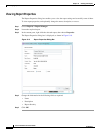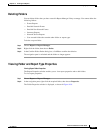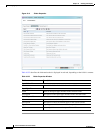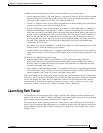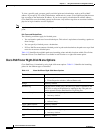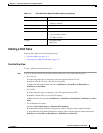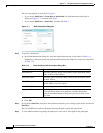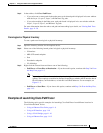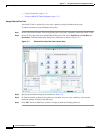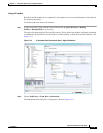
11-2
Cisco Prime Network 4.0 User Guide
OL-29343-01
Chapter 11 Using Cisco PathTracer to Diagnose Problems
Cisco PathTracer Overview
By default, users with the Administrator role have access to all managed elements. To change the
Administrator user scope, see the topic on device scopes in the Cisco Prime Network 4.0 Administrator
Guide.
Cisco PathTracer Overview
Cisco PathTracer enables you to launch end-to-end route traces and view related performance
information for Layer 1, Layer 2, and Layer 3 traffic. Upon receiving a path's start and endpoint,
Cisco PathTracer visually traces the route through the network. For example, in an ATM network
environment, Cisco PathTracer identifies all information regarding the connection of a subscriber to a
provider, including all ATM PVCs, ATM switching tables, ATM class of service (CoS) definitions,
IP-related information, and so on.
You can also use Cisco PathTracer to:
• Trace paths using IPv4, IPv6, or both IPv4 and IPv6 addresses for the source and destination.
• Trace a hypothetical Ethernet frame from a VLAN interface to a specified MAC address.
• Trace a hypothetical Ethernet frame from an Ethernet interface to a specified MAC address within
a specific VLAN identifier.
Table 11-1 Default Permission/Security Level Required for Working with Cisco PathTracer -
Element Not in User’s Scope
Task Viewer Operator OperatorPlus Configurator Administrator
Launch a path trace — — — — X
View path information — — — — X
Save Cisco PathTracer
map files
————X
Save Cisco PathTracer
counter values
————X
Rerun a path and
compare results
————X
Table 11-2 Default Permission/Security Level Required for Working with Cisco PathTracer -
Element in User’s Scope
Task Viewer Operator OperatorPlus Configurator Administrator
Launch a path trace — X X X X
View path information — X X X X
Save Cisco PathTracer
map files
—XXXX
Save Cisco PathTracer
counter values
—XXXX
Rerun a path and
compare results
—XXXX



